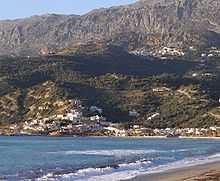Plakias



Plakias (Greek: Πλακιάς) is a village on the south coast of the Greek island of Crete, in the Rethymno regional unit, about 30 kilometres south of the city of Rethymno. It is part of the municipal unit Foinikas. It is surrounded by mountains to the north and the Libyan Sea to the south. The name in Greek means "flat", because the town stands on an alluvial fan of material that has washed down the Kotsifou gorge directly to the north . This material has formed along the sea's edge into a long, fine, gold-hued sand beach, which shelves very gradually out into the bay, making it quite safe for swimming and hence, for family holidays.
Initially just a fishing jetty and a few houses, Plakias developed during the last few decades into a tourist resort. The first official mention of Plakias was in 1961, when it was recorded in a census as the permanent home of six fishermen. The recorded history of surrounding mountain villages like Myrthios and Sellia goes back to the 10th century, when the Byzantine Emperor Nikephoros II Phokas (961 AD) built roads and bridges in order to link those villages, and there are some fragments of wall remaining from a fortified area on a hill top just northeast of the present main town . The local area is geographically suitable for a settlement, having plenty of agricultural space, and there may well have been a settlement there since Minoan times .
Plakias has a 1300 metre long sandy beach and there are several other beaches within walking distance (Souda, Damnoni, Ammoudi and Skhinaria). The south-eastern end of the beach, near the Kakomouri headland, is used by nudists. The town is not on any major thoroughfare and hence has minimal traffic and is quieter and less dusty than many other Greek resorts.
Parking along the main town road is difficult in high season, but visitors should note that there is a large, free parking area just east of the main town . There are plenty of places to eat along the sea front with the biggest cluster of tavernas at the west end . To the east (8 km) is the historic Monastery of Preveli, which may have been founded as early as the 10th century CE. Due to its isolated position, it has played an important role in Cretan revolts against occupying forces such as the Nazis in World War II. Plakias is home to the "Youth Hostel Plakias", set in olive groves behind the town, and which is famous among international backpackers as the 'most southerly hostel' in Europe. Also well-known are the cafes "Nufaro", (known locally as "Joe's bar"), and the very traditional "Niko's Souvlaki". "World International Tourism Day" each September is celebrated with a big evening festival, with a free buffet meal and free traditional music, songs, and dancing performances in the main square.
There are two roads down into Plakias through the mountain range which lies to the north, both of which run through spectacular gorges - to the north of Plakias, the Kotsifos Gorge, and to the northeast, the Kourtaliotiko Gorge. A good coastal motor track runs west beyond Souda to Rodakino beach, Frango-kastello and Sfakia . There are plenty of walks locally, and bolder walkers will enjoy the high green country beyond the coastal mountain range north of town . Mountain biking and cycle touring are other local attractions.
There are several buses daily to and from Rethymnon bus station; some of these go via Preveli Monastery. The Plakias bus stop is on the seafront taxi rank .
External links
| Wikimedia Commons has media related to Plakias. |
Coordinates: 35°11′N 24°23′E / 35.183°N 24.383°E